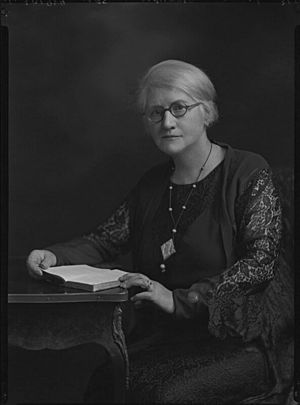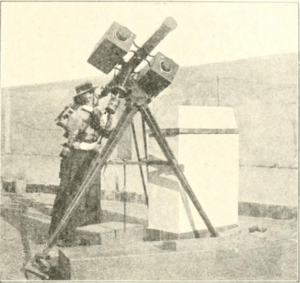Annie S. D. Maunder facts for kids
Quick facts for kids
Annie Scott Dill Maunder
|
|
|---|---|

Annie S. D. Maunder in 1931
|
|
| Born |
Annie Scott Dill Russell
14 April 1868 Strabane, County Tyrone, Ireland
|
| Died | 15 September 1947 (aged 79) Wandsworth, London, England
|
| Nationality | British |
| Other names | Annie Russell Maunder |
| Known for | Astronomy |
| Spouse(s) | Edward Walter Maunder (1851–1928) |
Annie Scott Dill Maunder (née Russell) FRAS (born April 14, 1868 – died September 15, 1947) was an amazing Irish-British astronomer. She was the first to show how sunspots move from the Sun's poles towards its middle during its 11-year cycle. Annie was a top astronomer of her time. But because she was a woman, her important work was often not fully recognized back then. In 1916, she was finally voted into the Royal Astronomical Society. This happened 21 years after they first said no to her because of her gender.
Contents
Early Life and Education
Annie Scott Dill Russell was born in 1868 in Strabane, Ireland. Her father was a minister, and her mother was also from a minister's family. Annie grew up in a very religious home with five brothers and sisters. All the children were very smart and good at school.
Annie and her older sister, Hester, went to the Ladies Collegiate School in Belfast. Annie won a special prize in 1886 when she was 18. This prize helped her get a scholarship to study at Girton College, Cambridge. She received £35 each year for three years.
In 1889, Annie finished her studies at Girton College with high honors. She was the best mathematician in her year at Girton. She also earned a high rank called "Senior Optime" in the university's results. Annie was the first woman from Ireland to achieve this rank. Even though she earned a bachelor's degree, Cambridge University did not give degrees to women until 1948.
Personal Life
Annie married Walter Maunder on December 28, 1895. She was 27, and Walter was 45. They did not have any children together. Walter had five children from a previous marriage. Annie was described as having a very active mind. She was also known for her "tireless zeal" in finding facts and working out details. Walter passed away in 1928 when he was 76. Annie died almost 20 years later in 1947, at the age of 79.
Astronomical Research
Working at the Royal Observatory
In 1890, Annie heard about a job at the Royal Observatory, Greenwich. She wrote many times to try and get the position. Her father and a famous scientist, Sir Robert Ball, also wrote letters for her. In 1891, Annie started working at the Royal Observatory. She was one of the "lady computers" in the solar department. This department took pictures of the Sun. Annie was paid £4 a month, which was not much money to live on.
Annie worked with Edward Walter Maunder on a program to photograph the Sun. She used a special camera to take pictures of sunspots. She also found their locations and studied their features. She spent a lot of time photographing the Sun and tracking many sunspots. In her first year, the solar department recorded seven times more observations than usual. Walter Maunder nominated her for the Royal Astronomical Society in 1892. In 1894, she became the editor of the British Astronomical Association (BAA) Journal. She held this job for 35 years.
Working with Walter
Annie had to leave her job at the Observatory when she married Walter in 1895. This was because married women were not allowed to work in public service jobs back then. Even so, Annie and Walter kept working together. Annie joined Walter on trips to see solar eclipses. Walter helped organize these trips.

In 1897, Annie received money from Girton College to buy a special camera. She took this camera on her trips. She used it to photograph the outer part of the Sun's atmosphere, called the solar corona, during an eclipse in India in 1898. With her own camera, she captured the longest ray, or coronal streamer, ever seen at that time. A writer named Agnes Clerke said, "Mrs. Maunder with her tiny lens has beaten all the big instruments." Annie's ideas about how particles moved in the corona were very advanced. They are similar to what we understand about the solar wind today.
In 1900, Annie went to Algiers to see another total solar eclipse. She photographed the corona and described "plume-like" rays, a term still used today. In 1901, the Maunders went to Mauritius for an eclipse. Annie had to pay her own way because she was not an official observer. She took her own photos from a different spot. One of the two published photos from Mauritius was Annie's. The only trip where Annie's costs were paid was to Canada.
Her Publications
In 1904, Annie and Walter created the "butterfly diagram." This diagram shows how sunspots appear at different latitudes on the Sun over time. It is a very important way to understand how the Sun works. Annie was not listed as a co-author on the paper about this diagram. Later, a famous physicist named Sydney Chapman used the butterfly diagram in a major speech. Annie considered this diagram one of her most important pieces of work.
Annie also wrote some papers with her husband. In 1907, she published a paper by herself. It was about sunspot data collected over 13 years. She found that sunspots were not spread evenly from east to west. This was a surprising discovery. Years later, her findings were confirmed by other scientists.
In 1908, Annie and Walter published a book called The Heavens and their Story. Annie was the main author. The book was written for people who were not scientists. It included her photos of the Sun and the Milky Way. They hoped it would get more people interested in astronomy. The book also talked about how magnetic storms on Earth were linked to sunspots. Their ideas about these storms were very advanced for their time.
Joining the Royal Astronomical Society
Annie was elected as a Fellow of the Royal Astronomical Society (RAS) in November 1916. This was ten months after the society started allowing women to join. She had first been nominated for the RAS 24 years earlier, in 1892. But she, along with two other women, did not get enough votes to join. One member even said that women would just be a distraction at meetings. Annie was very upset by this unfair treatment against women in her field.
Legacy
- A crater on the Moon is named Maunder after both Walter and Annie Maunder.
- The Maunder Minimum, a period when there were very few sunspots, is also named after them.
- In 2016, the Royal Astronomical Society created the Annie Maunder medal. This award is for people who do great work in sharing astronomy with the public.
- In 2018, a new telescope was put in at the Royal Observatory, Greenwich. It is called the Annie Maunder Astrographic Telescope (AMAT).
- In 2022, a special blue plaque was put on Annie and Walter Maunder's old home in London. This plaque honors them.
- Also in 2022, a satellite was launched into space and named "Annie" after her.
See also
 In Spanish: Annie Scott Dill Maunder para niños
In Spanish: Annie Scott Dill Maunder para niños

